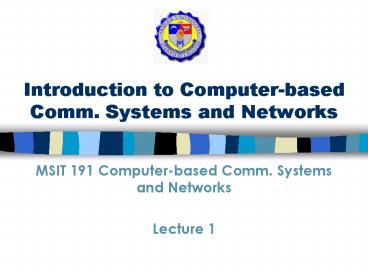Introduction to Computerbased Comm' Systems and Networks - PowerPoint PPT Presentation
1 / 18
Title:
Introduction to Computerbased Comm' Systems and Networks
Description:
WWW, email, games, e-commerce, database., voting, more? communication services ... mobile. XU Department of Computer Science. Assignment 1: Computer-based Comm. ... – PowerPoint PPT presentation
Number of Views:28
Avg rating:3.0/5.0
Title: Introduction to Computerbased Comm' Systems and Networks
1
Introduction to Computer-based Comm. Systems and
Networks
- MSIT 191 Computer-based Comm. Systems and
Networks - Lecture 1
2
A Communications Model
- Source
- generates data to be transmitted
- Transmitter
- Converts data into transmittable signals
- Transmission System
- Carries data
- Receiver
- Converts received signal into data
- Destination
- Takes incoming data
3
Simplified Communications Model - Diagram
4
Key Communications Tasks
- Transmission System Utilization
- Interfacing
- Signal Generation
- Synchronization
- Exchange Management
- Error detection and correction
- Addressing and routing
- Recovery
- Message formatting
- Security
- Network Management
5
Simplified Data Communications Model
6
Networking
- Why? - Point to Point Communication not Usually
Practical - Devices are too Far Apart
- Large Set of Devices would need Impractical
Number of Connections - Solution is a Communications Network
- Wide Area Network (WAN)
- Metropolitan Area Network (MAN)
- Local Area Network (LAN)
7
Simplified Network Model
8
Wide Area Networks
- Large geographical area
- Crossing public rights of way
- Rely in part on common carrier circuits
- Alternative technologies
- Circuit switching
- Packet switching
- Frame relay
- Asynchronous Transfer Mode (ATM)
- Integrated Services Digital Network (ISDN)
9
Metropolitan Area Networks
- Limited geographical area
- Crossing public rights of way
- Rely in part on common carrier circuits
- Alternative technologies
- Circuit switching
- Packet switching
- Frame relay
- Asynchronous Transfer Mode (ATM)
- Nomenclature is arbitrary - a MAN is technically
similar to a WAN.
10
Local Area Networks
- Smaller scope
- Building or small campus
- Usually owned by same organization as attached
devices - Data rates much higher
- Usually broadcast systems
- IEEE 802.2 Logical Link Control
- IEEE 802.3 - Ethernet
- IEEE 802.4 - Token bus
- IEEE 802.5 - Token ring
- IEEE 802.11 Wireless
- GigE 10GigE
- Now some switched systems and ATM are being
introduced
11
Uses of computer-based communication systems and
networks
- sharing of computing resources
- access to remote programs
- access to remote databases
- communication
- support net-centric, client/server and
distributed computing
12
Whats the Internet a service view
- communication infrastructure enables distributed
applications - WWW, email, games, e-commerce, database., voting,
- more?
- communication services provided
- connectionless
- connection-oriented
- cyberspace Gibson
- a consensual hallucination experienced daily by
billions of operators, in every nation, ...."
13
Net-centric computing (NCC)
- A distributed environment where applications and
data are exchanged among peers across a network
on as as-needed basis. NCC relies on portable
applications running on multiple platforms,
mobile code and data accessed via high-speed
network connections, and low-cost appliances for
local processing (from 3rd International Workshop
on Net-Centric Computing May 14, 2001 Toronto,
Canada) - The traditional PC is history net-centric
computing is the future. But what form will it
take? Computing appliances, "connected PCs,"
Web-enabled set-top boxes, Webphones,
Internet-connected wireless communicators, or
Java-based network computers? (from Emergence of
Net-Centric Computing The Network Computers,
InternetAppliances, and Connected PC's, Bernard
Cole, 1999)
14
Client/server computing
- general software architecture (3-layered)
- presentation layer (user interface)
- application logic
- generalized services (e.g., file services, print
services, communications services, and database
services) - one-tier, two-tier, three-tier, and n-tier
client/server program architectures - thin client and a fat client
- middleware
15
Distributed computing
- Distributed computing is a science which solves a
large problem by giving small parts of the
problem to many computers to solve and then
combining the solutions for the parts into a
solution for the problem. Recent distributed
computing projects have been designed to use the
computers of hundreds of thousands of volunteers
all over the world, via the Internet, to look for
extra-terrestrial radio signals, to look for
prime numbers so large that they have more than
one million digits, and to find more effective
drugs to fight the AIDS virus. These projects are
so large, and require so much computing power to
solve, that they would be impossible for any one
computer or person to solve in a reasonable
amount of time. (from Internet-based Distributed
Computing Project Web site http//www.aspenleaf.co
m/distributed/)
16
Basic network hardware and software components
- Hardware
- Computers
- Network Interface cards
- Repeaters, Hubs
- Switches, Routers
- Transmission Media
- Software
- Applications and Services
- Network operating system
- Protocols and standards
17
Whats the Internet nuts and bolts view
- protocols control sending, receiving of msgs
- e.g., TCP, IP, HTTP, FTP, PPP
- Internet network of networks
- loosely hierarchical
- public Internet versus private intranet
- Internet standards
- RFC Request for comments
- IETF Internet Engineering Task Force
router
workstation
server
mobile
local ISP
regional ISP
company network
18
Assignment 1 Computer-based Comm. Systems or
Network of an Organization
- Approach a local organization that has a
computer-based comm. system or network facility
(e.g. LAN or campus network) and find out the
following - Uses of the facility
- Network software components
- Network hardware components
- Transmission media/telecommunication links
- Connection to the outside world (if any)
- Technical and management problems (if any)
- Submit a 2-4 page write-up of your findings
- Due 24 Nov. 2001































